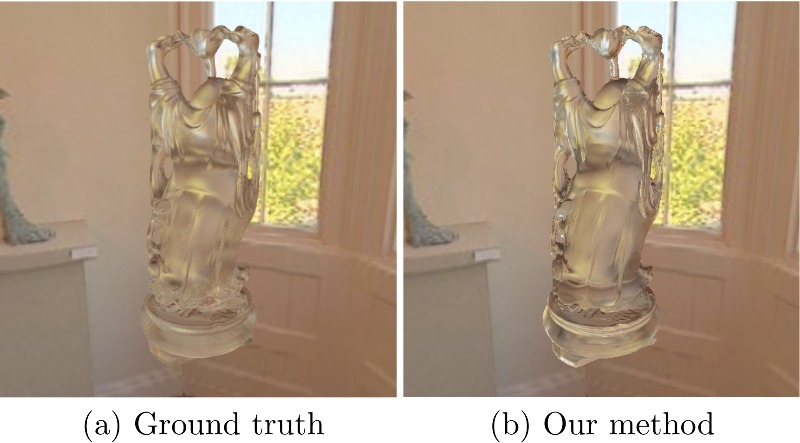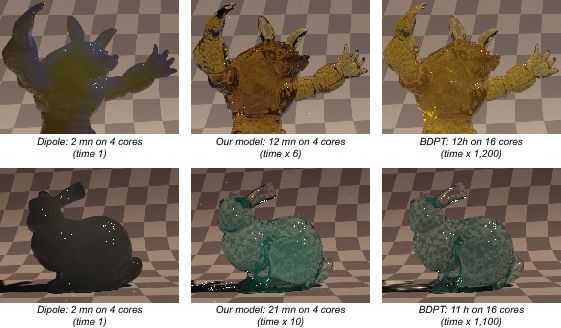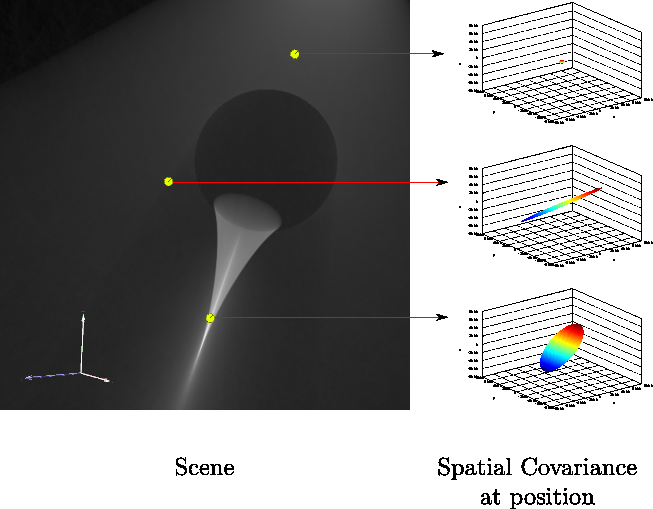Section: New Results
Illumination simulation
Accurate fitting of measured reflectances using a Shifted Gamma micro-facet distribution
Participants : Mahdi M. Bagher, Cyril Soler, Nicolas Holzschuch.
Material models are essential to the production of photo-realistic images. Measured BRDFs provide accurate representation with complex visual appearance, but have larger storage cost. Analytical BRDFs such as Cook- Torrance provide a compact representation but fail to represent the effects we observe with measured appearance. Accurately fitting an analytical BRDF to measured data remains a challenging problem. In this paper we introduce the SGD micro-facet distribution for Cook-Torrance BRDF. This distribution accurately models the behavior of most materials. As a consequence, we accurately represent all measured BRDFs using a single lobe. Our fitting procedure is stable and robust, and does not require manual tweaking of the parameters (Figure 10 ).
Interactive rendering of acquired materials on dynamic geometry using bandwidth prediction
Participants : Mahdi M. Bagher, Cyril Soler, Kartic Subr, Laurent Belcour, Nicolas Holzschuch.
Shading complex materials such as acquired reflectances in multi-light environments is computationally expensive. Estimating the shading integral involves sampling the incident illumination independently at several pixels. The number of samples required for this integration varies across the image, depending on an intricate combination of several factors. Adaptively distributing computational budget across the pixels for shading is therefore a challenging problem. In this paper we depict complex materials such as acquired reflectances, interactively, without any precomputation based on geometry. We first estimate the approximate spatial and angular variation in the local light field arriving at each pixel. This local bandwidth accounts for combinations of a variety of factors: the reflectance of the object projecting to the pixel, the nature of the illumination, the local geometry and the camera position relative to the geometry and lighting. We then exploit this bandwidth information to adaptively sample for reconstruction and integration. For example, fewer pixels per area are shaded for pixels projecting onto diffuse objects, and fewer samples are used for integrating illumination incident on specular objects (Figure 11 ).
|
Real-Time Rendering of Rough Refraction
Participants : Charles De Rousiers, Adrien Bousseau, Kartic Subr, Nicolas Holzschuch, Ravi Ramamoorthi.
We present an algorithm to render objects made of transparent materials with rough surfaces in real-time, under all-frequency distant illumination (Figure 12 ). Rough surfaces cause wide scattering as light enters and exits objects, which significantly complicates the rendering of such materials. We present two contributions to approximate the successive scattering events at interfaces, due to rough refraction: First, an approximation of the Bidirectional Transmittance Distribution Function (BTDF), using spherical Gaussians, suitable for real-time estimation of environment lighting using pre-convolution; second, a combination of cone tracing and macro-geometry filtering to efficiently integrate the scattered rays at the exiting interface of the object. We demonstrate the quality of our approximation by comparison against stochastic ray-tracing. Furthermore we propose two extensions to our method for supporting spatially varying roughness on object surfaces and local lighting for thin objects.
Multiple-scattering and double-scattering effects in translucent materials
Participants : Jean-Dominique Gascuel, Nicolas Holzschuch.
Some materials, such as coffee, milk or marble, have a soft translucent aspect because of sub-surface scattering: light enters them, is scattered several times inside before leaving in a different place. A full representation of sub-surface scattering effects in illumination simulation is computationally expensive. The main difficulty comes from multiple scattering events: the high number of events increases the incertainty on the result, forcing us to allocate more time for the computations. In this paper, we show that there is a strong correlation between the surface effects of multiple scattering inside the material and the effects after just two scatter events. This knowledge will help for accelerating multiple scattering effects.We also provide a model for fast computation of double-scattering events, using a precomputed density function we store in a compact way (Figure 13 ).
Frequency analysis of participating media
Participants : Laurent Belcour, Cyril Soler, Kavita Bala.
Computing global illumination in participating media is frustratingly expensive: while the computation itself is long and complicated, the result involve very smooth regions of illumination. This motivates an a priori approach to find out how fast the resulting image will vary in space (i.e. it's spatial frequency) to adapt computation effort to reach the maximal efficiency. For this we are extending the theory of Fourier Analysis of light transport to participating media. Our work builds on the covariance analysis of light transport developed by Laurent Belcour in his PhD Thesis. It offers the possibility to drastically accelerate the algorithms involved in the computation of the illumination in scenes with participating media (Figure 14 ).







